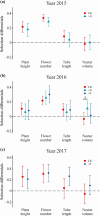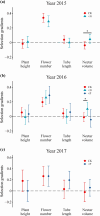Nutrient Enrichment Alters Phenotypic Selection on Plant Traits in an Annual Herb on the Tibetan Plateau
- PMID: 40519892
- PMCID: PMC12166381
- DOI: 10.1002/ece3.71592
Nutrient Enrichment Alters Phenotypic Selection on Plant Traits in an Annual Herb on the Tibetan Plateau
Abstract
Nutrient enrichment is an increasingly important consequence of anthropogenic activities. Nutrient enrichment can alter the composition, diversity, and functioning of terrestrial plant communities, yet its effect on evolutionary processes in plant populations has been less well studied. To understand the evolutionary consequence of long-term soil nutrient enrichment, we examine the effects of nutrient addition (N or P) on plant traits, female reproductive success, and pattern of phenotypic selection in the annual plant Pedicularis szetschuanica M. in an alpine meadow on the Tibetan Plateau. Nutrient addition generally increased plant height and reduced tube length and nectar production per flower. Surprisingly, the effects of N and P addition on seed number per plant were reversed between years. Despite variation in traits, mean fitness, and opportunity for selection among nutrient treatments, patterns of selection changed only for nectar production, where we detected N-mediated selection favoring greater nectar production. This study suggests that nutrient enrichment can alter patterns of phenotypic selection, potentially influencing the evolution of floral traits even if pollinators play a limited role in selection.
Keywords: Pedicularis szetschuanica; alpine meadow; floral traits; nutrient addition; phenotypic selection.
© 2025 The Author(s). Ecology and Evolution published by British Ecological Society and John Wiley & Sons Ltd.
Conflict of interest statement
The authors declare no conflicts of interest.
Figures


Similar articles
-
Proximity to oilseed rape fields affects plant pollination and pollinator-mediated selection on a co-flowering plant on the Tibetan Plateau.Evol Appl. 2023 Mar 5;16(4):814-823. doi: 10.1111/eva.13538. eCollection 2023 Apr. Evol Appl. 2023. PMID: 37124085 Free PMC article.
-
Drought drives selection for earlier flowering, while pollinators drive selection for larger flowers in annual Brassica rapa.AoB Plants. 2025 Jan 8;17(1):plae070. doi: 10.1093/aobpla/plae070. eCollection 2025 Jan. AoB Plants. 2025. PMID: 39867861 Free PMC article.
-
Sexually concordant selection on floral traits despite greater opportunity for selection through male fitness.New Phytol. 2024 Jan;241(2):926-936. doi: 10.1111/nph.19370. Epub 2023 Oct 29. New Phytol. 2024. PMID: 37899633
-
Evolutionary ecology of nectar.Ann Bot. 2019 Jan 23;123(2):247-261. doi: 10.1093/aob/mcy132. Ann Bot. 2019. PMID: 30032269 Free PMC article. Review.
-
Untangling the Complexity of Climate Change Effects on Plant Reproductive Traits and Pollinators: A Systematic Global Synthesis.Glob Chang Biol. 2025 Feb;31(2):e70081. doi: 10.1111/gcb.70081. Glob Chang Biol. 2025. PMID: 39996366 Free PMC article.
References
-
- Ashman, T. L. , Knight T. M., Steets J. A., et al. 2004. “Pollen Limitation of Plant Reproduction: Ecological and Evolutionary Causes and Consequences.” Ecology 85: 2408–2421. 10.1890/03-8024. - DOI
LinkOut - more resources
Full Text Sources

